Special combat crossbow Big John 5 (USA)
When conducting reconnaissance or sabotage, Special Forces fighters from the Office of Strategic Services could face the need for the quiet and quick elimination of the enemy - the guard at the post or the watchdog. Pistols with silencers could not always be fairly quiet, and therefore the development of special weapons continued. Not later than the end of 1942, OSS experts suggested recalling a long-obsolete class of weapons - crossbows. It was assumed that such weapons, characterized by minimal noise, will have some advantages over firearms.
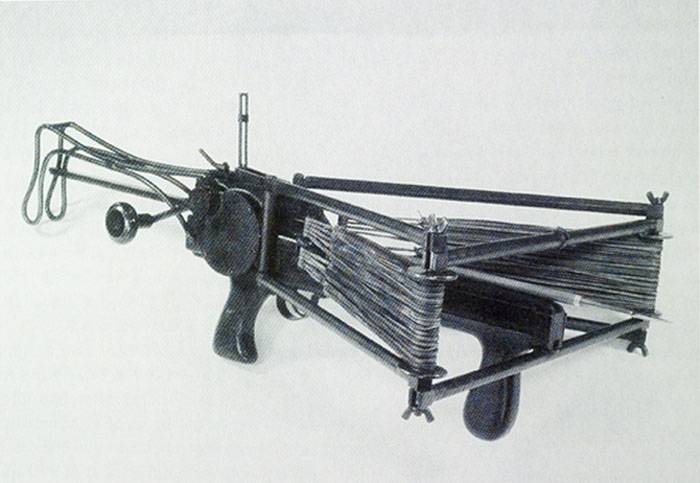
Crossbow Big Joe 5 in cocked state. Photo by Thetruthaboutknives.com
Soon, the OSS officers, with the assistance of several scientific and commercial organizations involved in the program, offered a number of options for combat crossbows. It should be noted that the new developments of the special services were crossbows only in name and, in part, in appearance. The fact is that in new projects it was proposed to throw arrows at the expense of the energy stored in rubber bands, while the traditional design of the crossbow uses flexible shoulders for these purposes. Thus, the development of the Office of Strategic Services on the principle of action, rather, were slingshots. However, the term “crossbow” was used for them, rather than the logical “slingshot”.
All new projects of “crossbows” were based on common ideas, but they were implemented in different ways and using different components. In particular, several products with different sizes and, as a result, different tactical and technical characteristics were developed. The largest weapon of the new line received the uncomplicated name Big Joe 5 - “Big Joe No. XXUMX”. It is easy to see that such a designation could only hint at the size of the weapon.
The Big Joe project provided for the crossbow to be made in a classic form factor with some innovations, due to the availability of modern technologies and materials, as well as the need to reduce the dimensions of the product in transport condition. In particular, the weapon received several folding elements, with the help of which it was ensured the convenience of carrying and quick transfer to the combat position. The most difficult stages of working with weapons were mechanized using simple devices with manual control.
The basic element of the crossbow was a simple wooden or plywood bed, which also served as the basis frame. The wooden device was a relatively long bar of sufficient height and width, on the lower part of which there was a pair of handles. The rear was used to control the shooting, the front facilitated the retention and pointing of the weapon. To hold the crossbow for the bar itself should not, because the moving parts of the weapon were not closed, and the shot could cause serious injury.
On the sides of the wooden parts were placed metal guides for mobile devices. Behind them, at the back, was a metal U-shaped casing with devices for cocking the weapon. There was also a hinge for mounting the butt and fastening for fixing it in the fighting position. On the right side of the rear casing there was a rotating lever with a cocking handle. Front of the casing provided for a pair of tubes for mounting the frame with harnesses.
Instead of the traditional shoulder-arms for crossbows that can be bent to tension the bowstring, the designers of OSS used a rigid frame made of metal tubes. With the help of vertical axes, four long tubes were fastened on the back casing, two at the top and bottom, with an angle directed forward. The front ends of these tubes were connected to a pair of transverse tubes and fastened with two vertical studs with wing nuts. In the fighting position of the arbalest, the tubes formed a rigid trapeziform shape in terms of shape. The additional rigidity of such a frame was ensured by strained harnesses and the connection of the lower front tube with the stock.
On the front vertical elements of the resulting frame, between the stops, a large number of rubber rings were fastened. For the correct distribution of the load and tension, a second metal rod was used, which also entered the rings. With the help of wire, it was connected to the moving parts of the weapon, which were responsible for accelerating the missile boom.
According to some reports, the frame with rubber harnesses, which is the largest and cumbersome element of the crossbow Big Joe 5, was made collapsible. If necessary, the shooter could remove the front part of it together with rubber harnesses and lay it along the arms. In addition, it was possible to open only one joint and lay all three parts of the frame, reducing the diameter of the weapon. The simplest details were used in the design of the crossbow, and therefore assembly and disassembly were not particularly difficult.
The wire from a pair of harnesses was fixed on a massive metal block, moving along the guides of the box. Its main part had hooks for contact with guides. In front there was a saddle to interact with the boom. Behind this block was attached a long rack, necessary for cocking the weapon and fire control.
The shank of the rail entered the rear U-shaped casing, inside of which there was a simple cocking and lowering mechanism. To prepare for the shooting, the fighter had to rotate the side cocking handle. After a couple of intermediate gears, the force was transmitted to the rack drive, which retracted it. A ratchet combined with a trigger was used to avoid a premature shot. After withdrawing the slats and the block with the saddle to the rearmost position, the weapon was cocked. By pressing the trigger of a traditional type, the rake was released, and the assembly assembled under the action of rubber bands went forward, dispersing the ammunition.
For shooting from the "Big Joe №5" a special bolt was developed. OSS designers suggested using a steel boom with a length of 14 inches (355 mm). The arrow had a metal shaft of a large elongation and could be equipped with tips of various shapes, from pointed conical to triangular lamellar. The plumage was made in the form of two triangular planes with a minimum span corresponding to the size of the box. It was proposed to create several variants of the bolt. Some were designed to destroy enemy personnel, while others were supposed to carry pyrotechnic compositions for various purposes. In particular, it is known about the creation of a lighting arrow.
According to preliminary calculations, the metal boom could be sent to a distance of up to 200-250 yards. Acceptable fighting qualities and adequate slaughter effect when firing on manpower remained at distances up to 80-100 yards.
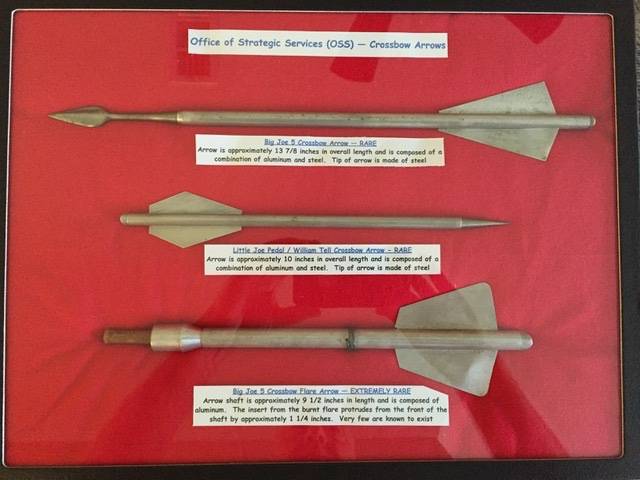
Arrows for OSS crossbows. Above is the bolt for the Big Joe. Photo Usmilitariaforum.com
The slingshot crossbow received uncomplicated sights. A ring on the front upper tube of the frame with harnesses was used as a fly. The role of the pillar was played by a thin long metal plate mounted vertically on the rear casing. Such a sight could not be adjusted in range.
In the back of the weapon it was proposed to mount a simple butt bent of thick wire. In the holes on the sides of the box were placed the ends of the wire, which served as the axis. The bent sections of the wire formed a pair of symmetrical shoulder supports connected by an additional bridge. The stock also contained an upper frame with which it could be fixed in the unfolded position.
The ergonomics of the Big Joe 5 product did not differ much. A pair of vertical handles were used to hold when shooting. The aimed fire could be carried out with the help of a butt. Perhaps, in the future, a crossbow could get an unshaped belt installation or even a special holster or bag for easy carrying.
According to known data, in 1942-43, specialists from the Office of Strategic Services and commercial enterprises involved in the project produced and tested a number of original crossbows of various types. Together with other samples that differed from each other in size and capabilities, they sent the Big Joe to the shooting range. Soon, various tests were carried out, which made it possible to draw the necessary conclusions and determine the further fate of the entire direction.
According to different sources, the product Big Joe 5 performed well at the shooting range and showed quite high performance. In practice, we managed to confirm that an unusual crossbow is really capable of sending an arrow at a distance of several tens of meters. At certain distances, flying ammunition retained sufficient energy and could be dangerous to humans or animals. However, with further increase in range, the slaughter effect was expectedly reduced. It is worth noting that other OSS developments showed similar results, however, in their case, the discussion initially focused on smaller effective firing ranges.
The main objective of the new projects was to reduce the noise produced by the shot. For this reason, during the tests, measurements of the sounds produced took place. Rubber harnesses and a movable metal block when shooting did not move silently, but still significantly inferior in volume to the shot of a firearm. In the case of the Big Joe # 5, the volume did not exceed 80 dB. Unfortunately, accurate information about the measurement method was not preserved, which does not allow to fully compare the special crossbow with weapons of other classes.
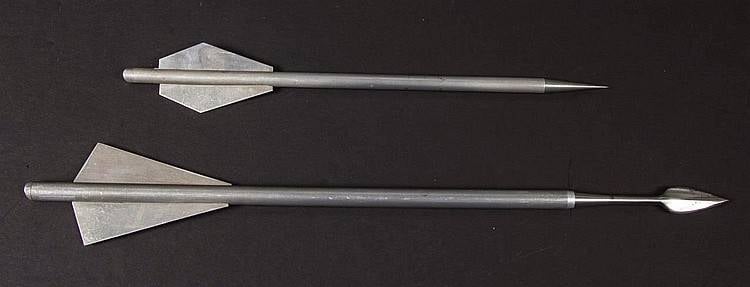
Other arrows for crossbows, Big Joe 5 ammunition - below. Photos Invaluable.co.uk
Not later than the first months of 1943, the management of the Office of Strategic Services drew conclusions and determined the further development of silent weapons for special operations. OSS Director William Joseph Donovan and his colleagues thought that the original crossbows - with all their advantages and strengths - are not very convenient for use in real operations in the rear of the enemy. Self-loading pistols and other small arms with silent firing devices could become a much more convenient tool for special forces.
Soon, this opinion was enshrined in principle and the relevant order of the leadership of the special services. Work on all crossbows were stopped in favor of firearms. Since 1943, self-loading HDM pistols have been supplied to OSS units, and over the next few years they received a total of 2600 of such products. Several hundred M3 submachine guns with silencers were purchased, not counting foreign-made weapons. Crossbows, including the Big Joe 5 remained in the number of several prototypes.
The fate of these products is unknown. Probably, they could be stored for some time, but later they were disposed of as useless. However, in some sources it is mentioned that several “Big Joe” got into special forces and were used in a few operations. If such events took place, then prototypes most likely participated in them.
As far as we know, several samples of crossbows for OSS survived the war and ended up in museums, but among them there was no Big Joe. Thus, now this version of the combat crossbow can be seen only in a few photographs.
According to known data, the command decided to abandon crossbows in favor of pistols with silencers for several main reasons. Home - at least, ambiguous performance. The crossbow on the basis of rubber harnesses when firing was noticeably quieter than an HDM pistol, but that’s where its advantages actually ended. All other features of such weapons could be considered flaws.
The Big Joe 5 crossbow was fairly large in size and weight, making it difficult to carry and fire, and in this respect it was inferior to any special pistol. Foldable design did not lead to a major improvement in convenience. Disassembling and assembling a crossbow slingshot took too much time, and for their acceleration required the most serious processing structure, which in the current situation simply did not make sense.
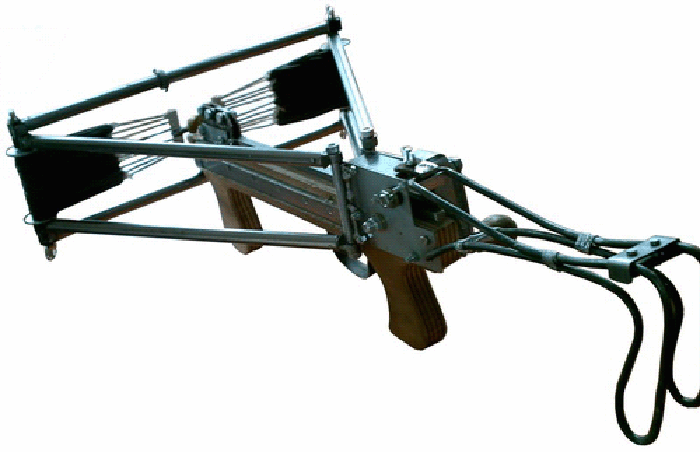
Modern reconstruction of the Big Joe 5 look. Drawing Weaponsman.com
A separate problem was the possibility of producing only one shot, after which a complex and lengthy recharge was required. You can imagine what problems this could lead to in a real operation. In particular, for the guaranteed defeat of the target - in case of a miss - simultaneous work of several shooters was required. Otherwise, there was a risk of unmasking with clear consequences.
In terms of technical, operational and combat characteristics, the Big Joe 5 crossbow didn’t look like the best model for special units. However, in almost all respects, it was inferior to the already existing silent pistol. In this situation, the decision of the management of the Office of Strategic Services did not look surprising. The bosses expectedly refused not the most successful weapons and the whole direction as a whole.
OSS refused combat crossbows already on the test results. Such weapons were not accepted for service, not produced in series and not used in practice. For the silent elimination of the watch, special forces used the less original, but simple and reliable small arms.
The Big Joe 5 combat crossbow project was part of a big and interesting attempt to solve an actual problem with non-standard ideas. From the point of view of technology, the problem was solved, albeit with significant shortcomings. However, the characteristic problems of this and other projects have seriously affected the prospects of the whole concept. Combat crossbows using rubber harnesses did not justify themselves, and they were abandoned.
On the materials of the sites:
http://weaponsman.com/
http://thetruthaboutknives.com/
https://popmech.ru/
http://peashooter85.tumblr.com/
http://usmilitariaforum.com/
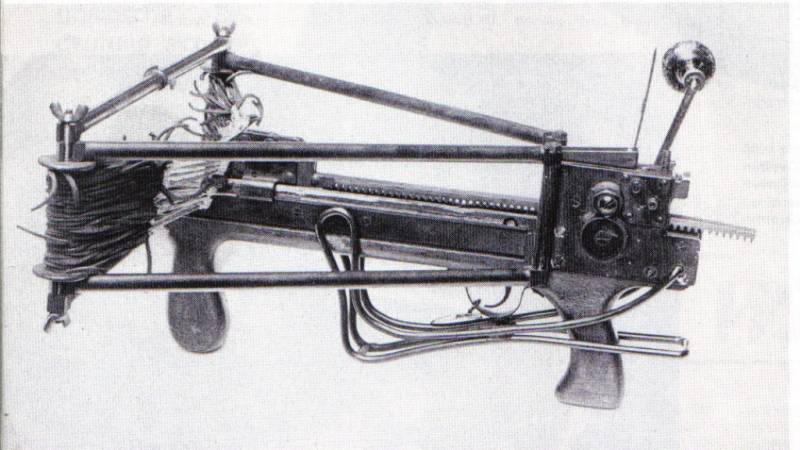
Information